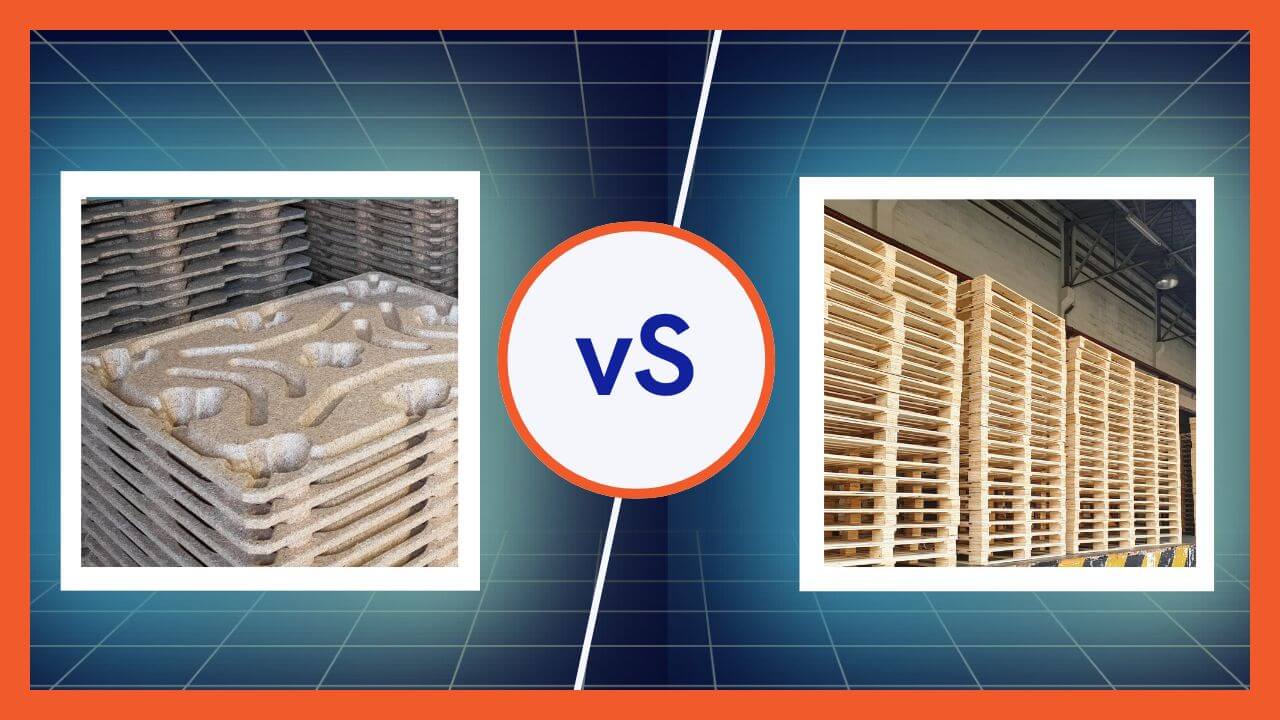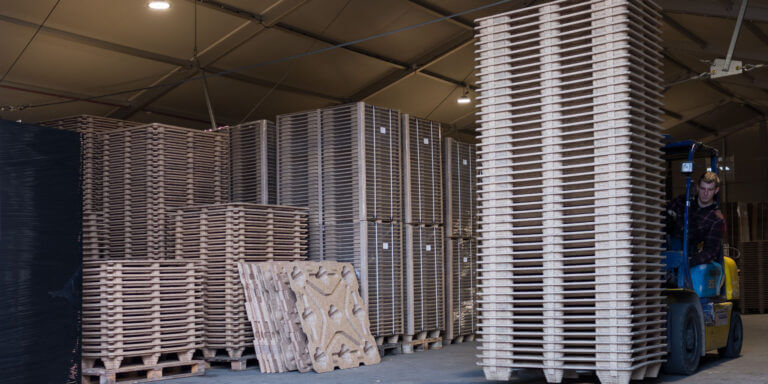Pressed palettes vs. wooden pallets: Which to win in a head-to-head battle?
Effective supply chain management is key not only to business success, but also to ensuring sustainability and reducing environmental impact. One of the basic but often underestimated elements in logistics is pallets. These simple structures are essential for transporting and storing goods, and their type can significantly affect costs and operational efficiency.
Pressed and wooden pallets are the two main categories between which logistics managers must choose. Both types have their advantages and disadvantages, which are worth considering before making a decision. Repeatedly, it can be seen that choosing the right type of pallet is key to optimizing processes and reducing costs, demonstrating the importance of understanding the characteristics of each.
In this article, we’ll take a closer look at pressed and wooden pallets, looking at their features, benefits and potential applications to help you choose the best solution for any business. I invite you to read what I hope will illuminate some of these key issues and help you make more informed decisions.
Characteristics of pressed pallets
Production and materials
Compressed pallets are made from wood chips or other lignocellulosic materials that are compressed under high pressure and temperature with the addition of a suitable adhesive. This makes these products not only economical, but also allows for better use of wood raw materials, which is beneficial from an environmental point of view. The technology also makes it possible to produce CUSTOM pallets in dedicated sizes and shapes, which is particularly valuable for customers who require specific solutions that perfectly fit their products and logistics processes.
Pressed pallets are single-use pallets by design, but if treated properly, they can be successfully used several times.
Advantages
Pressed pallets offer many benefits that make them attractive to many industries.
Their light weight significantly reduces transportation costs, which is important especially in international transport, where every kilogram matters.
Their smooth and uniform surfaces minimize the risk of damage to goods, which is especially important when transporting sensitive or valuable items. They are also easier to clean, which is crucial in industries that require high hygiene, such as the food and pharmaceutical industries.
With the ability to nest one pallet into another and stack stably, they significantly save storage and transportation space. This makes it possible to optimize cargo space and increase transportation efficiency.
Pressed pallets are insect-resistant and meet ISPM-15 standards, relieving companies of the need to carry out costly phytosanitary treatments. This feature makes them particularly attractive to industries operating in international markets.
In addition, they are fully recyclable, reducing waste and environmental impact. The process is efficient and economical, and the recycled materials can be used to produce new pallets.
Disadvantages
Despite its many advantages, pressed pallets also have some limitations.
Although resistance to uniformly distributed loads is high, these pallets can be sensitive to point loads.
They also have lower impact resistance – special care should be taken during loading and unloading, as imprecise operations, such as driving the forks of a forklift into a pallet leg, can result in damage to the pallet.
Characteristics of wooden pallets
Production and materials
Wooden pallets are traditionally made from different types of wood, depending on the region of production and availability of raw material. Their production does not require high temperature or pressure, which makes them simpler and cheaper to produce than their pressed counterparts. Pallets are assembled from planks and blocks that are nailed or screwed together. This simplicity in manufacturing makes wooden pallets readily available and can be quickly customized in a variety of sizes and designs.
Advantages
One of the main advantages of wooden pallets is their durability. They are capable of handling heavy and unevenly distributed loads, making them suitable for industries that require robust logistics solutions.
When treated properly, they can be used repeatedly and repaired easily, giving them a long life.
They are also characterized by greater resistance to mechanical damage than pressed pallets, which is important for intensive use.
Their popularity and wide availability make them a frequent choice of many companies.
Disadvantages
However, wooden pallets are not without flaws either.
Their main weakness is their susceptibility to moisture and pests such as insects and mold. This requires special care in storage and use. It can also result in the need for more frequent replacement, which in turn increases the overall cost of ownership.
In addition, according to ISPM-15, exporters using wooden pallets are required to carry out phytosanitary treatments, which generates additional costs for companies operating in international markets.
Another problem is the unevenness of the surface, which can lead to damage to the goods being transported, which is particularly problematic for delicate or highly sensitive products.
In addition, the greater weight of wooden pallets increases transportation costs, which is a disadvantage in terms of logistics cost management.
They are also not as environmentally friendly as pressed pallets, as their production process often involves greater consumption of energy and raw materials.
Specialty applications
Automotive industry
Pressed pallets are particularly valued in the automotive industry because of their adaptability to specific logistics requirements. Due to their precise dimensions and ability to be custom-designed, these pallets are ideal for transporting and storing automotive parts such as engines, transmissions or other components that require stable and secure packaging. Due to their uniformity, pressed pallets minimize the risk of damage during transport and facilitate the automation of loading and unloading processes.
Chemical industry
In the chemical industry, pressed pallets are chosen for their resistance to various types of substances. Their smooth, non-porous surface cleans easily and is resistant to most chemicals, preventing product contamination. In addition, pressed pallets do not generate sparks, which is crucial in areas where flammable materials are stored or transported. They are also lightweight and easy to handle, enhancing worker safety and efficiency of logistics operations in such a demanding environment as the chemical industry.
White goods/RTV industry
For manufacturers and distributors of household appliances and consumer electronics, where products are often fragile and require extra protection, pressed pallets offer an excellent solution. Their stability, uniform construction and lack of protruding nails or screws minimize the risk of scratches or other damage during transportation.
With the option to create CUSTOM pallets, it is possible to precisely match the dimensions and shapes of pallets to specific products, allowing the transported products to be nested in a specially modeled pallet, providing additional protection and stability during transport.
In addition, the ability to nest pallets allows efficient use of space in both transportation and warehouses, which is invaluable when handling large volumes of products.
Summary
In this article, we looked at the two main types of pallets used in logistics: pressed pallets and wooden pallets. Each type has its own unique advantages and limitations that should be considered when deciding whether to use them in different industries.
Pressed pallets are valued mainly for their light weight, unique design and ability to create dedicated transportation solutions. Their design ensures optimal use of transportation and storage space, resulting in increased operational efficiency and reduced costs. In addition, the pallet’s ability to perfectly match the embossing of the pallet to the shape of the goods being transported, as well as its resistance to most chemicals, make these pallets more secure and stable for cargo. The weaknesses of these pallets are their relatively low resistance to point loads and susceptibility to mechanical damage.
On the other hand, wooden pallets, with their durability and reusability, remain a suitable choice in conditions that require higher resistance to loads and harsh external conditions. However, their susceptibility to moisture and pests, their greater bulk, and the need for thoughtful disposal, present challenges that require attention.
Recommendations for logistics managers
The considerations presented here show that the choice of the right type of pallet should be dictated not only by the initial cost, but also by the long-term operational and environmental benefits. Supply chain management in modern market conditions requires flexibility and innovation, and proper pallet selection is one of the key elements of this process.
The future of pallets in logistics
The evolution of pallets in logistics seems to be moving toward greater specialization and customization for specific industries. An emphasis on implementing environmentally friendly solutions is also evident. Technological innovations, such as the development of new materials and manufacturing techniques, will certainly influence the way pallets are designed, manufactured and used in the coming years.




